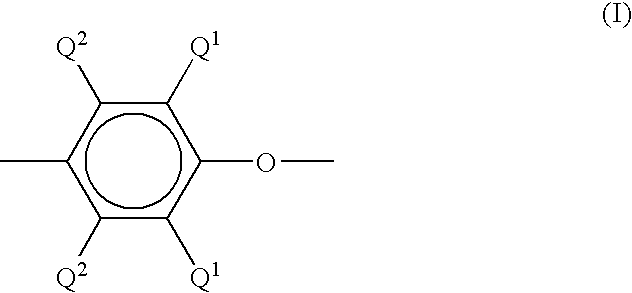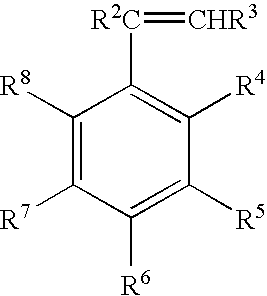Reinforced poly(arylene ether)/polyamide composition
a technology of polyamide and arylene ether, which is applied in the direction of film/foil adhesives, tyre parts, conductive materials, etc., can solve the problems of high moisture absorption, physical properties, drawbacks of polyamides,
- Summary
- Abstract
- Description
- Claims
- Application Information
AI Technical Summary
Problems solved by technology
Method used
Image
Examples
examples
The following examples were prepared using the materials listed in Table I. The examples also contain less than 1 weight percent stabilizers and anti-oxidants. The amounts shown in Tables II and III are in weight percent. Weight percent, as used in the examples, was determined based on the total weight of the composition.
TABLE IMaterial NameMaterial Description / SupplierPPE IA polyphenylene ether with anintrinsic viscosity of 0.46 dl / g asmeasured in chloroform at 25° C.SEBS IPolystyrene-poly(ethylene-butylene)-polystyrene impact modifiercommercially available from KratonPolymers as G1651.PA9T IAn aliphatic-aromatic polyamidehaving an amine end group content of80 micromoles per gram of polyamideand a melt viscosity of 3000 poise at ashear rate of 1000 s−1 and 330° C.PA9T IIAn aliphatic-aromatic polyamidehaving an amine end group content of77 micromoles per gram of polyamideand a melt viscosity of 2000 poise at ashear rate of 1000 s−1 and 330° C.PA9T IIIAn aliphatic-aromatic polyami...
examples 1-10
Poly(arylene ether), polyamide, impact modifier, and, fumaric acid (as shown in Table II) were added at the feed throat of a 30 millimeter Werner and Pfleider twin screw extruder and melt mixed at a screw speed of 350 rotations per minute and a feed rate of 13.6 kilograms per hour and a temperature of 305° C. The glass fibers were added downstream. The material was pelletized and formed by injection molding the pellets and tested for heat deformation temperature, Notched Izod impact strength, and / or multi axial impact strength. Formulations and results are shown in Table II.
TABLE IIComponent1*2*3*4*5*6*7*8910PE38.638.641.541.541.52222222222PA9T I————41.5——47——PA9T II———41.5————47—PA9T III—50———————47PA6,6 I—————47————PA6,6 II50—41.5———47———SEBS10105.85.85.8—————Fumaric Acid0.50.50.50.50.50.50.50.50.50.5Glass Fibers——1010103030303030Flexural modulus—————76728160789075878076Multi-Axial Impact: 23° C.51.759.83.23.62.9—————Notched Izod: 23° C.223255———90.188.49185.588.1% Elongation a...
PUM
| Property | Measurement | Unit |
|---|---|---|
| Temperature | aaaaa | aaaaa |
| Temperature | aaaaa | aaaaa |
| Time | aaaaa | aaaaa |
Abstract
Description
Claims
Application Information
 Login to View More
Login to View More - R&D
- Intellectual Property
- Life Sciences
- Materials
- Tech Scout
- Unparalleled Data Quality
- Higher Quality Content
- 60% Fewer Hallucinations
Browse by: Latest US Patents, China's latest patents, Technical Efficacy Thesaurus, Application Domain, Technology Topic, Popular Technical Reports.
© 2025 PatSnap. All rights reserved.Legal|Privacy policy|Modern Slavery Act Transparency Statement|Sitemap|About US| Contact US: help@patsnap.com


